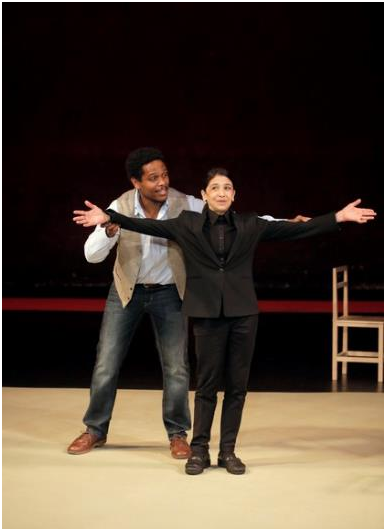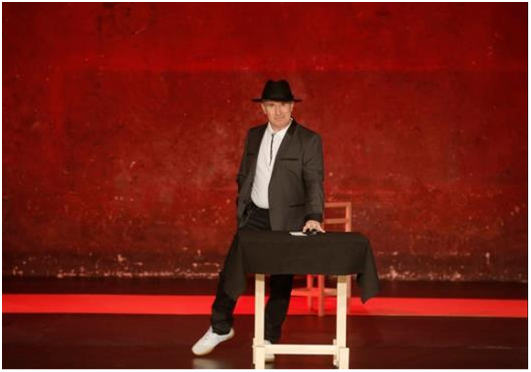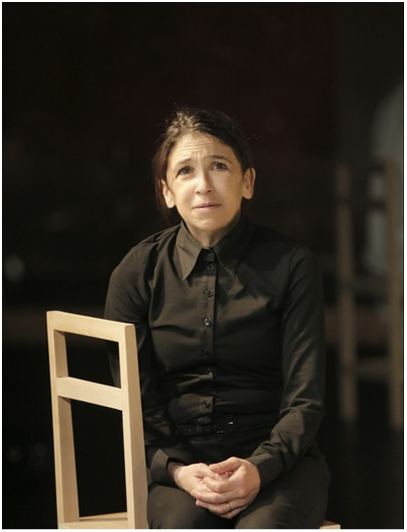The Valley of Astonishment

Jared McNeill and Kathryn Hunter in a
scene from The Valley of Astonishment
(Photo credit: Pascal Victor)
Almost as a follow-up to his 1992 The Man Who (inspired by the work of neurologist Dr. Oliver Sacks), theater legend Peter Brook along with his long-time collaborator Marie-Hélène Estienne have sent their latest stage work to Theatre for a New Audience for a three-week run as part of its international tour. The Valley of Astonishment delves into the phenomenon of synesthesia, the ability to use one sense when another is called upon, such as seeing colors when words are mentioned or pictures for numbers. Using a cast of three international actors (all of whom have worked with Brook and Estienne before) and an almost empty space, The Valley of Astonishment tells the fascinating stories of three people whose brains push the usual limits of human capacity. Running only 80 minutes, this provocative piece not only dramatizes its neurological journey in theatrical terms but is also a metaphysical investigation. Told in the simplest of language, it is accessible to all to whom theater is a necessity.
Brook who turns 90 next year has been creating cutting edge theater for 70 years. He is best known in New York for such landmark productions as King Lear (1964) with Paul Scofield, Marat/Sade (1965) with Ian Richardson and Glenda Jackson, A Midsummer Night’s Dream (1971) with Ben Kingsley, Alan Howard, Frances de la Tour and Patrick Stewart, and his reinvention of La Tragedie de Carmen (1983)
with rotating casts. However, since 1970 he has been creating new texts in Paris at the Theatre Bouffes du Nord with his International Centre for Theatre Research know in France as C.I.R.T. Among these productions that have traveled to New York are The Mahabharata, The Man Who (Oliver Sacks), The Grand
Inquisitor (Dostoyevsky), Fragments (Samuel Beckett), Love Is My Sin (Shakespeare sonnets), and The Suit (Can Themba), seen at Brooklyn Academy of Music in January of this year.

Marcello Magni in a scene from
The Valley of Astonishment
(Photo credit: Pascal Victor)
The bulk of the play is made up of the story of Samy Costas played by Kathryn Hunter, seen a year ago at Theatre for a New Audience as Puck in Julie Taymor’s A Midsummer Night’s Dream. Samy, a journalist who never appears to take notes, is sent by her editor to a laboratory for neurological psychology to be tested. Marcello Magni and Jared McNeill play the doctors who test her and discover both her extraordinary memory and how she accomplishes this feat by seeing words as pictures. When she is fired by her boss for being too intelligent, she becomes a member of a theatrical act as a professional mnemonist. After she has had great success on the stage, she discovers a new nightmare: she cannot forget all of the names and numbers she has been asked to recall and is haunted by this mental clutter. This requires her to return to the doctors for help. Samy is inspired by the real life of Solomon Shereshevsky told in Alexander Luria’s book The Mind of a Mnemonist.

Kathryn Hunter in a scene from
The Valley of Astonishment
(Photo credit: Pascal Victor)
Magni (who has appeared in the Brook/Estienne Fragments and The Magic Flute) also plays a patient who, though paralyzed, is able to control his limbs if he can look at them. McNeill (the narrator of Brook/Estienne’s The
Suit) visits the doctors as a man who sees jazz as colors and is able to become a painter. Magni returns as a one-armed magician who uses members of the audience in the most remarkable card tricks. All of the stories are based on true cases with the names (and in some cases the genders) changed. Throughout the performance, the action is accompanied by soulful live music played by Raphaël Chambouvet (keyboard) and Toshi Tsuchitori (strings and percussion). While the stories are immediately accessible like fables, they are the kind of tales that take a good deal of thinking about at a future time to totally understand their import.
Generally the actors talk directly to the audience as though they are telling us their own stories. The magician (based on the life of René Lavand) blurs the lines even more by calling up members of the audience to participate in the legerdemain in his magic act. Hunter, Magni and McNeill, chameleons all, seem to be doing no acting as they seemingly become the real people of the play. While the uncredited white set in the Polonsky Shakespeare Center’s black box Samuel H. Scripps Mainstage uses several blonde wood chairs and a table to tell its story, the subtle lighting by Philippe Vialatte floods the stage in solid colors at various times to show us what the different subjects see, as well as for theatrical effects. The title and opening lines come from the Persian epic poem, The Conference of Birds, previously adapted to the stage by Brook and Estienne, in 1979.
A program note by the authors, “As we explore the mountains and valleys of the brain, we will reach the valley of astonishment,” explains the metaphor of the title. The Valley of Astonishment is a little play that will fascinate you long after you have left the theater. It is the work of theater artists of the highest caliber.
The Valley of Astonishment (through October 5, 2014)
C.I.C.T./Théâtre des Bouffes du Nord
Theatre for a New Audience, Polonsky Shakespeare Center
262 Ashland Place. Between Lafayette Avenue and Fulton Street, in Brooklyn
Running time: 80 minute with no intermission

Leave a comment